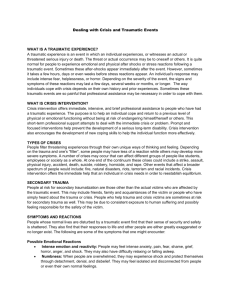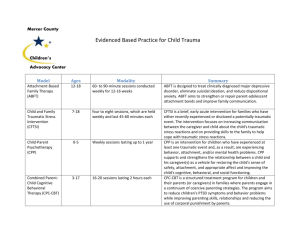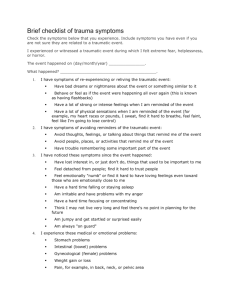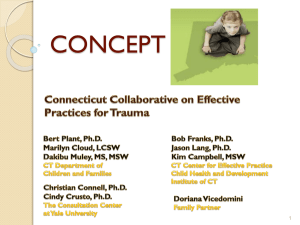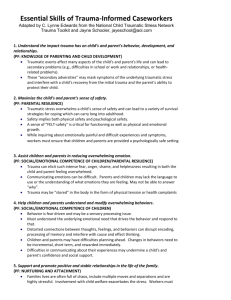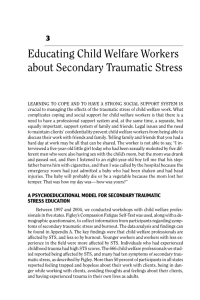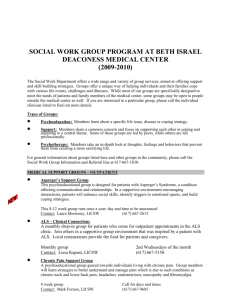Theme 6.6: VT STS Common Ground Article 3
advertisement
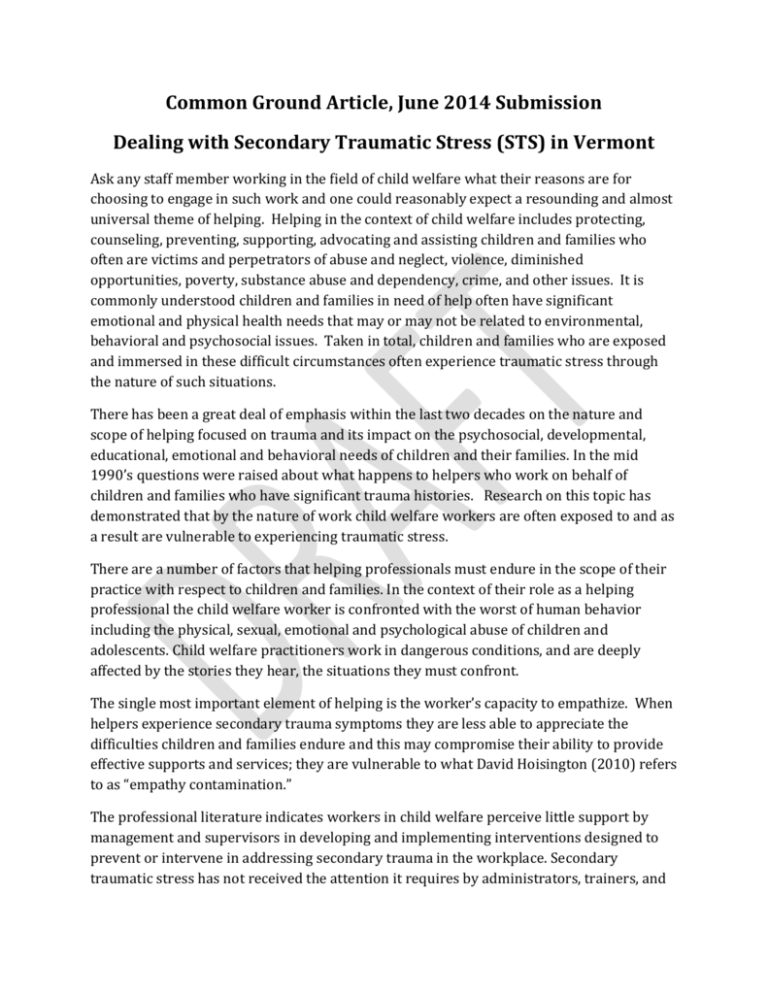
Common Ground Article, June 2014 Submission Dealing with Secondary Traumatic Stress (STS) in Vermont Ask any staff member working in the field of child welfare what their reasons are for choosing to engage in such work and one could reasonably expect a resounding and almost universal theme of helping. Helping in the context of child welfare includes protecting, counseling, preventing, supporting, advocating and assisting children and families who often are victims and perpetrators of abuse and neglect, violence, diminished opportunities, poverty, substance abuse and dependency, crime, and other issues. It is commonly understood children and families in need of help often have significant emotional and physical health needs that may or may not be related to environmental, behavioral and psychosocial issues. Taken in total, children and families who are exposed and immersed in these difficult circumstances often experience traumatic stress through the nature of such situations. There has been a great deal of emphasis within the last two decades on the nature and scope of helping focused on trauma and its impact on the psychosocial, developmental, educational, emotional and behavioral needs of children and their families. In the mid 1990’s questions were raised about what happens to helpers who work on behalf of children and families who have significant trauma histories. Research on this topic has demonstrated that by the nature of work child welfare workers are often exposed to and as a result are vulnerable to experiencing traumatic stress. There are a number of factors that helping professionals must endure in the scope of their practice with respect to children and families. In the context of their role as a helping professional the child welfare worker is confronted with the worst of human behavior including the physical, sexual, emotional and psychological abuse of children and adolescents. Child welfare practitioners work in dangerous conditions, and are deeply affected by the stories they hear, the situations they must confront. The single most important element of helping is the worker’s capacity to empathize. When helpers experience secondary trauma symptoms they are less able to appreciate the difficulties children and families endure and this may compromise their ability to provide effective supports and services; they are vulnerable to what David Hoisington (2010) refers to as “empathy contamination.” The professional literature indicates workers in child welfare perceive little support by management and supervisors in developing and implementing interventions designed to prevent or intervene in addressing secondary trauma in the workplace. Secondary traumatic stress has not received the attention it requires by administrators, trainers, and supervisors. This is truly unfortunate given the linkage between secondary traumatic stress and child welfare. Trauma in all its variations is a significant problem. Helping those who help others, particularly in child welfare is critical to protecting the integrity of the service delivery systems and to ensure the health and well-being of those who deliver these important services. Earlier this year, a course was offered at the University of Vermont on trauma, led by Laurie Brown, LICSW and Jessica Strolin, Ph.D. Three of the participants in this course, Melanie D’Amico, MSW, the DCF Client Placement Specialist, Andrea Grimm, BSW, Social Work Supervisor, and Tim Fleming, MSW, Social Worker, arrived at the conclusion that helping workers with secondary stress symptomology is an important initiative. Ms. D’Amico advocated with the DCF - Family Services management team for a policy initiative to be developed. She has established a committee to develop a policy ensuring that all DCF – Family Services staff receive appropriate, on-going, as well as acute services designed to prevent, reduce and alleviate secondary traumatic stress. The committee, chaired by Ms. D’Amico, consists of: Laurie Brown, LICSW of UVM, VT-FACTS; Dr. Robert Walsh Ed.D., LICSW, ACSW, of The College of St. Joseph; Sonny Provetto, LICSW, Ph.D. candidate, who is in private practice working with police in dealing with traumatic stress; Tim Fleming, MSW, Brattleboro DCF; Andrea Grimm, BSW, Middlebury DCF; and Beth Maurer, MSW, DCF-FSD, VT-FACTS. A copy of a proposed draft requiring implementation of secondary trauma symptom prevention and secondary trauma symptom intervention will be available for review soon. The advantage of developing this policy is to not only help those who provide services to vulnerable children and families, but to also eliminate the discretionary nature of providing such services. While the current policy initiative is currently being developed specifically for the Vermont Department for Children and Families, Family Services Division, the committee supports this policy being expanded to include other Departments, Divisions and Agencies. The committee members believe that creating and sustaining an emotionally healthy workforce by acknowledging, preventing, and treating secondary traumatic stress will result in better outcomes for the vulnerable population on whose behalf we work. Respectfully submitted by the Vermont Secondary Traumatic Stress Committee
